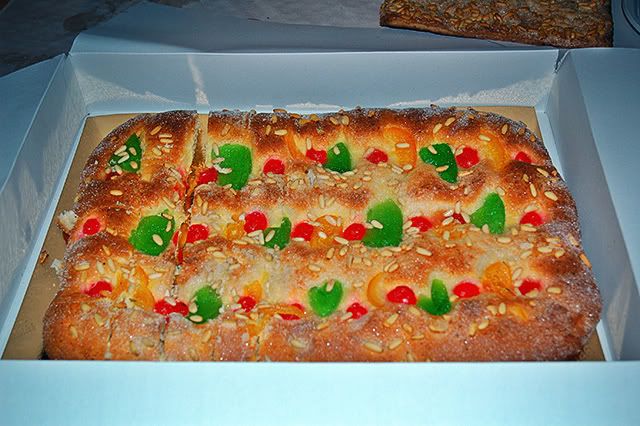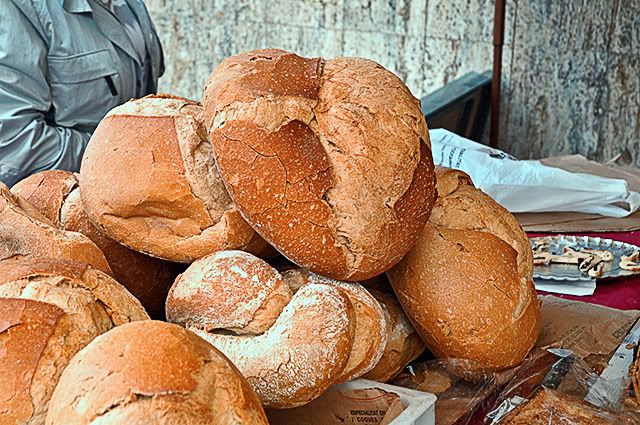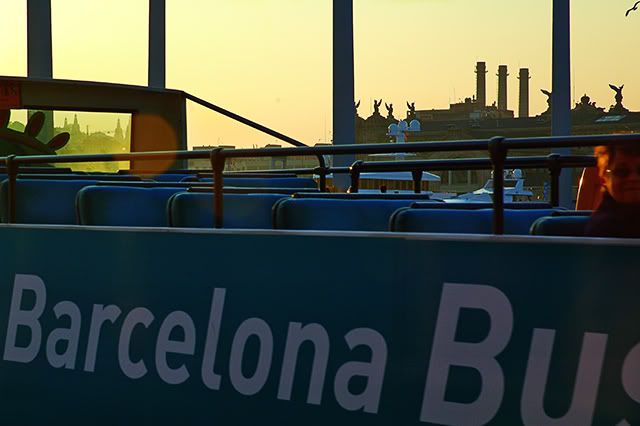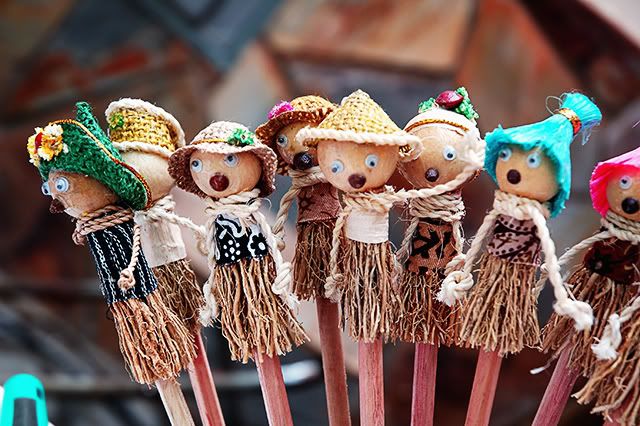Barcelona photos: Daily photographs of Barcelona, Spain. Pictures of a modern city with travel tips in a personal photoblog. A photography and travel site. Art, architecture, people and traditions. Travel to Barcelona through my camera, know more about our city and towns nearby. Welcome!
Wanna be featured?
June 26, 2008
June 25, 2008
Candied Fruit Pastry or Coca de Sant Joan

This is what is known as coca de Sant Joan, a traditional light sweetbread covered with candied fruit. As the name suggests, it is a kind of pastry to be consumed during Saint John celebrations when it is sold in huge amounts and as you can guess there are the cheap and the expensive ones. They can be tasty and spongy or an authentic hard rock. The cheapest you buy at the supermarket but if you want the best stuff then you'd better go to your favorite pastry shop. Besides the candied fruit "coca", there are other kinds, like coca de crema (cream filled pastry - this is the one I like the most), coca de llardons (suet pastry)...to have a better idea learn about cocas de San Juan. Maybe you prefer the recipe: Candied Fruit and Pinenuts Cocas.
June 24, 2008
Sant Joan Firecrackers: Launching Gadget Closeup
The word petardo in Spanish or petard in Catalan has different meanings: banger, firecracker, that is, a small explosive device. Not only that, it can be someone or something that's boring. Sometimes it can be a fraud but the most curious entries are "a hag, an old hag" what we know as a petarda and a joint, you know, the smoking kind. My intention today was to show not only firecrackers but the gadgets some people use to launch the artifacts. Many are completely handmade and others can be bought in stores. By the way, firecrackers are sold at special stalls which are regulated by city authorities. Normally they are located in the middle of a square with some fences all around and only two clients can be in front of the counter at the same time. Apart from that, you can also find specialized shops and major dealers for professional purposes.
June 23, 2008
Sant Joan's Eve Firecrackers
Bonfires of Saint John (Fogueres de Sant Joan in Catalan) aka Nit de Sant Joan or Revetlle de Sant Joan on June 23rd is time for firecrackers (petardos), cocas (a sort of pastry) and cava which is in other words the Catalan version of champaign. If you follow the above link you will find out that this event intended to welcome the arrival of summer is not exclusively ours although we celebrate it perhaps more intensely than in other places. It must be said that bonfires are not as popular now as in the past when people used to take old furniture into the middle of the street to watch it burn and party all around. Now you have to go to the beach where the city council still allows bonfires and massive celebrations. The mess is so big that special brigades of garbage collectors have to be organized to clean up the sand from all sorts of bottles, shoes, and assorted crap. Most of us avoid these mega parties and gather with family and friends to eat and drink till late in the evening. All night long before and after supper we find some place in the garden or go to the nearest square to ignite firecrackers. In spite of all this you can hear firecrackers big and small, during the whole month of June. The one in the picture was a turning wheel not particularly dangerous. Some others are scaring just like the sort of big tube a friend of us tied up to a pole. The artifact got twisted upon burning and sent "shrapnel" against the big bucket where we had the beers on ice, piercing through it and leaving a big hole that emptied the whole thing in seconds.
June 22, 2008
Polinesian Ship Attraction in Port Aventura, Tarragona, Spain
And here's another attraction at Port Aventura amusement park in Tarragona. The ship is located in the Polinesia area. I am not very fond of this one. I get sick with the ups and downs. This time I stood in the shade and calmly composed my picture. Don't forget to click on the image for a better view!
June 21, 2008
Pear Tree Flowers
Just some pear tree flowers I happened to shoot at the beginning of spring, if there ever was spring this year. Summer is already here, hot weather and all. Not that we had too many sunny days in the past two months.
June 20, 2008
Bacon but not Francis
To continue in my quest for a surprising topic that kills monotony a little bit I'd like to add another picture about Spanish food. I know many of you prefer to get in touch with local stuff be it culture, architecture, traditions or food rather than contemplating my last abstraction or the picture I took of my reflection in the mirror, you know. I hope you don't get too disappointed because I don't show Barcelona streets lately. It's just that I prefer being eclectic. Besides, the ugliest of things like bacon in this case may be interesting if you try to work out the best way to make it look attractive. In other words, you can have fun with you camera with the most obvious things. There was a previous post I recommend you visit too: Bacon: A Still Life Portrait and perhaps you'd like to check a curious site called I Heart Bacon.
Labels:
bacon,
food,
pork,
still life
June 19, 2008
Sausage Spread or Sobrasada
Sobrasada (Sausage Spread) is in the group of sausages made with pork. It is prepared with minced meat and lard. The great amount of Spanish paprika or "pimentón" gives it the characteristic color and the peculiar flavor. Sobrasada is a Majorcan speciality. Although you can buy it all over Spain, the authentic, the one that really makes a difference, is from Majorca in the Balearic Islands.
June 18, 2008
Spanish Food: Aged Manchego Cheese
![Spanish Food: Aged Manchego Cheese [enlarge]](https://i63.photobucket.com/albums/h135/carloslorenzo/AgedManchegoCheese_.jpg)
Named after La Mancha which is the Spanish region of famous Don Quixote, these aged Manchego cheese are made of sheep milk. They say the aroma reminds of lanolin and roast lamb. It has a slightly briny, nutty flavor and at the age of 13 weeks it is considered cured (curado). Over that period it is referred to as aged (viejo). There are other well known kinds of Spanish cheese: Cabrales, Idiazabal, Zamorano, Tetilla, Liebana, Roncal...In Catalonia we have Mató de Montserrat which is a fresh cheese (formatge fresc). From the Balearic Islands, specifically from Menorca, we have Mahon cheese which is one of my favorites. A link today: The Encyclopedia of Cheese.
June 17, 2008
June 16, 2008
Pan de Payés or Pa de Pagès: Traditional Peasant's Bread in Catalonia

When you visit Barcelona or other cities and towns in Catalonia you will surely taste this bread known as pa de pagès, pan de payés or pan de pueblo (peasant or people's bread). Don't be scared you don't have to hold it and take a bite, just eat it in slices. At the baker's they'll cut it up for you. Maybe you have seen similar bread before since many Mediterranean products are already familiar to you in your country. What I am sure some of you are not aware of is what we do with the slices of pagès bread . But let's talk about this traditional Catalan product first.
El pa de pagès or pan de payés is a thick crusted bread with abundant crumb, higher carbohydrate content and less fat than a normal loaf. The thick crust is obtained thanks to a long kneading and fermentation time and a slow baking process. Due to its characteristics it is classified as a rustic kind of bread and as you already must have guessed by the name, people working in the fields were and still are the main consumers. As to the possible ways to serve the slices, there are lots of them. You can have them as such, although they are better in toasts, normally the ones popped into a barbecue grill taste better. Once you've got the toasts, you preferably spread tomato on top. How?
How to prepare pa amb tomàquet or toast with tomato
You cut the tomato into halves and rub it against the toast. Normally, you are given some garlic, olive oil and tomatoes together with the toasts so you wonder what about the garlic? Garlic is just an option although it is used on many occasions. If you have a knack for garlic then it is important that you cut one clove in two and rub it against the bread toast before spreading tomato, otherwise it is almost impossible to rub. Voila, you are almost there. Now you take the olive oil recipient, pour some on top of the slice of bread and finally add some salt. This part, which is the basis to prepare dozens of different kinds of pa de pagès toasts, is called pantumaca or pa amb tomàquet (bread with tomato pulp). The toast or the slice can then be dressed up with cured ham, anchovies, omelet, sausages, red peppers and aubergines in strips, all sorts of cheese...The ideal situation is to have high quality extra virgin olive oil from local olive oil producers although local does not always mean good. There are great olive oil regions like Cordoba or Lleida that are remarkably good at this. Try not to use any odd supermarket oil and see if you can buy those recently cropped real juicy and ripe tomatoes that are not hard to find in farmers' markets around many Catalan towns.
June 15, 2008
Wooden Donkey at Torrelles de Llobregat Market near Barcelona
June 14, 2008
Pickled Green Tomatoes in Barcelona
These pickled green tomatoes caught my attention at a street market. The bowl I found among other kinds of pickle products like olives or onions. It is not very common here to see green tomatoes prepared that way, at least not for us in Barcelona city. I was standing there preadjusting my camera settings and I had the opportunity to listen to some customers talking to the man in the stall. "Are these olives?" - they asked with surprise. "No, those are green tomatoes from Valencia" - said the stall man. It's a rather ridiculous story but I found the comparison between olives and green tomatoes rather ackward. Here is a green tomato pickle recipe.
Labels:
food,
green,
market,
vegetables
June 13, 2008
Lantana Closeup in Barcelona
This is a lantana I came across in some Barcelona garden. It has been a very rainy season in the city in spite of the water crisis of past months so flowers look healthier than ever and make good photographs. Check an older picture of Lantanas. Have a nice weekend everyone!
June 12, 2008
Espadrilles: Spanish Alpargatas or Catalan Espardenyes
es·pa·drille (sp-drl) n. A shoe usually having a fabric upper part and a sole made of a flexible material, such as rope or rubber. The term espadrille is French and derives from espardenya, which derives from espart, the Catalan name for esparto [from Latin spartum] , a tough, wiry Mediterranean grass used in making rope. Espadrilles have been made in Catalonia since the 14th century at least. Here is a good place to buy yourself some comfortable espardenyes.
June 11, 2008
Street Market: Colorful Ribbons or Bracelets With Girl Names
Something I like about street markets in Barcelona and the rest of the country is that many times when you don't like what you see you can always go and refresh your eyes with the explosion of colors of South American stands. I mean, there is always a Bolivian or Peruvian stall where you don't know exactly what's on sale but you can't help staring with curiosity. Something is telling you that you want to buy. Not because of the pottery, the Che Guevara or Bob Marley T-shirts and the familiar leaf silhouette, not because of these personalized ribbons or bracelets with girl names but because of the whole impression, the warm colors, the Latin flashy hues that make the stand look more appealing than the rest. For me, much better than a 50 percent off sign.
June 10, 2008
Rusty Door Knocker in Torrelles de Llobregat , Barcelona, Spain
This beautiful rusty door knocker I captured at Torrelles de Llobregat near Barcelona although it could have been in Barcelona city perfectly as here we have many. The knocker represents some kind of mythological being perhaps. What do you make of it? I think I kind of like old door knockers and maybe I collect them in the future, the images of course. I remember a couple of posts in Barcelona Photoblog that you should check too: Vandalized Door Knocker or Modern Art? and Knocker on Chocolate Color Door at El Raval Quarter, Barcelona. Or maybe you prefer a list of famous door knockers.
June 09, 2008
Bobbin Lace or Encaje de Bolillos, Torrelles de Llobregat, Barcelona, Spain

This is a picture I took in Torrelles de Llobregat. You can see here in detail how bobbin lace, known in Spanish as encaje de bolillos, is made.
First you need a pattern or parchment where holes are pricked to mark the place for all the pins. The parchment is always laid on a pillow or cushion. The lace is worked with each hand holding at least a pair of bobbins, the wooden elongated spools or shuttles hanging from the threads, which are moved from side to side to form a twist, a braid, or a clothlike fabric called toile. The motifs are worked in a more dense stitch, and the ground is made with a looser stitch.
Bobbin lace originated in Flanders in the early 16th century although some say it came from Italy. From Flanders it extended to the rest of Europe. It was used for ruffs and collars back then.
In Spain it was customary to teach girls how to work bobbin lace at school and at home as it was considered an essential part of a woman's education.
Check this video about bobbin lace. It is short and not too illustrative but it has a brief explanation in English that might help.
Labels:
bobbin lace,
lace,
traditions
Location: Barcelona, Spain
Torrelles de Llobregat, Barcelona, Spain
June 08, 2008
Maracatu Percussion Band, Festa de la Cirera, Torrella de Llobregat, Barcelona
June 07, 2008
Cherry Festival (Festa de la Cirera), Torrelles de Llobregat, Barcelona
![Cherry Festival (Festa de la Cirera), Torrelles de Llobregat, Barcelona [enlarge]](https://i63.photobucket.com/albums/h135/carloslorenzo/CherryFestival-TorrellesdeLlobregat.jpg)
With these cherries I would like to introduce you to the Festa de la Cirera (cherry festival and market) celebrated in Torrella de Llobregat this weekend. This small town from Xth c. is only some kilometers away from Barcelona city. In fact Torrelles is a municipality in the Baix Llobregat comarque on the right bank of Llobregat river (one of the two rivers surrounding Barcelona). I have some more pictures which I'll show you in coming posts. Check Torrelles de Llobregat on Google maps.
The annual cherry festival at Torrelles de Llobregat holds deep historical significance in the Catalan region. Dating back centuries, the tradition was born out of the area's fertile soil and ideal climate for cultivating cherries. Catalan cherry orchards have long been renowned for their exceptional quality and distinctive taste.
Over time, the festival has evolved into a cherished cultural event, serving as a platform to honor the centuries-old cherry-growing heritage. It has become a symbol of community pride, where locals come together to celebrate their agricultural traditions and pay homage to the land that sustains them.
The festival's roots can be traced to the age-old practice of organizing fairs to showcase the region's bountiful harvest. Torrelles de Llobregat, with its picturesque countryside dotted with cherry trees, became the perfect setting to host this annual gathering.
Through the centuries, the festival has witnessed the evolution of cherry cultivation techniques, the introduction of new varieties, and the advancement of cherry-related industries. Today, it stands as a testament to the resilience and passion of Catalan cherry growers who have preserved this cultural heritage through generations.
The annual cherry festival not only offers a delightful gastronomic experience but also serves as a living history book, reminding us of the traditions, skills, and dedication that have shaped Catalonia's renowned cherry industry.
Subscribe to:
Posts (Atom)
Labels
architecture
(164)
modernisme
(82)
art nouveau
(74)
gaudi
(74)
food
(67)
flowers
(63)
street artist
(55)
sculpture
(48)
barri gotic
(39)
las ramblas
(39)
sagrada familia
(33)
dancers
(29)
beach
(28)
amusement park
(27)
port
(27)
human statue
(26)
art
(25)
mosaic
(25)
tibidabo
(25)
guell
(23)
sant pau
(23)
barcelona streets
(22)
tips
(22)
Catalan traditions
(21)
barcelona shop
(21)
market
(21)
montjuic
(21)
gothic quarter
(19)
domenech i montaner
(18)
la boqueria market
(18)
opinion
(18)
carnival
(17)
christmas
(17)
costa brava
(17)
ciutadella
(16)
maremagnum
(16)
folklore
(15)
classic
(14)
balcony
(13)
modernist
(13)
sea
(13)
street art
(13)
barcelona hotels
(12)
catalan art nouveau
(12)
catalan towns
(12)
costumes
(12)
graffiti
(12)
la pedrera
(12)
stained glass
(12)
casa mila
(11)
casa modernista
(11)
door
(11)
fountain
(11)
history
(11)
barcelona market
(10)
ceiling
(10)
la rambla
(10)
barcelona port
(9)
bikes
(9)
chocolate
(9)
crafts
(9)
paper mache
(9)
pedralbes
(9)
port aventura
(9)
vintage
(9)
architects
(8)
cosmocaixa
(8)
harbor
(8)
hotel
(8)
motorbike
(8)
passeig de gracia
(8)
arc de triomf
(7)
classic cars
(7)
dali
(7)
gracia
(4)
palau de la musica
(4)
accommodation
(3)
barcelona bar
(3)
casa batllo
(2)
cheese
(2)
cruises
(2)
gracia quarter
(2)
ham
(2)
wine
(2)
hostel
(1)
parc guell
(1)
picasso
(1)


